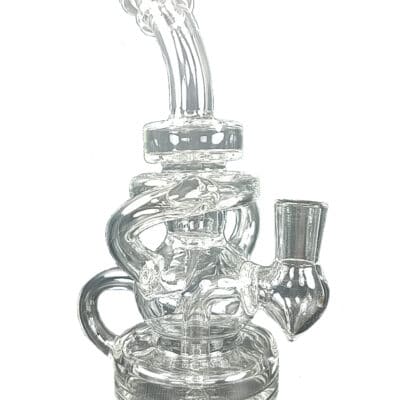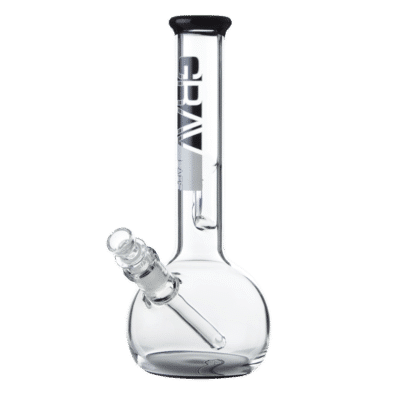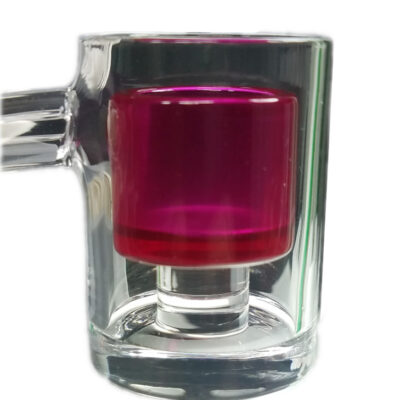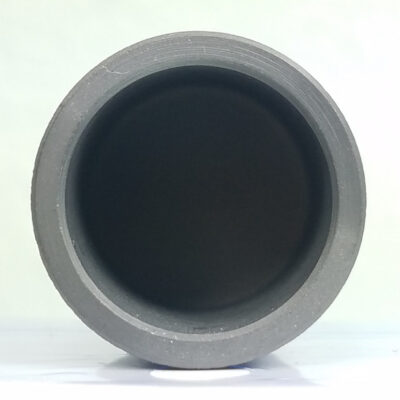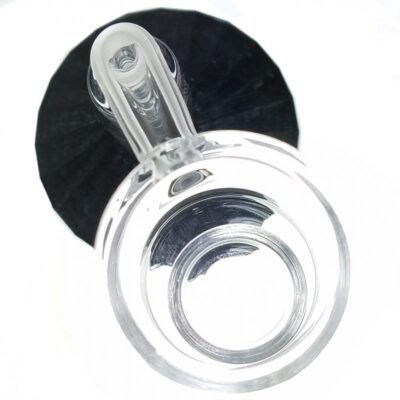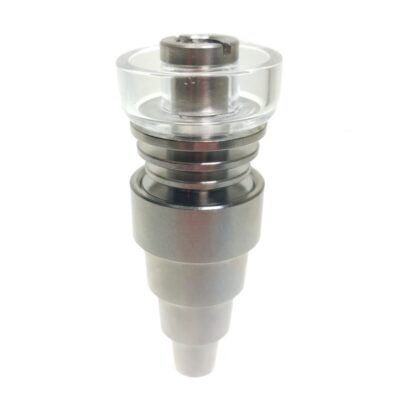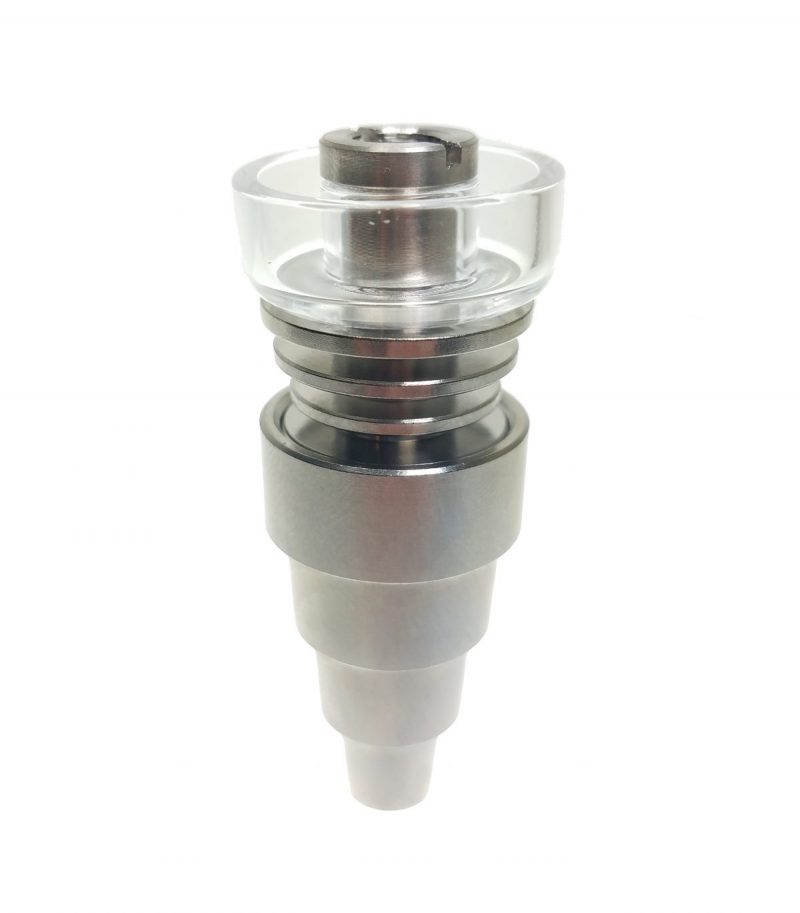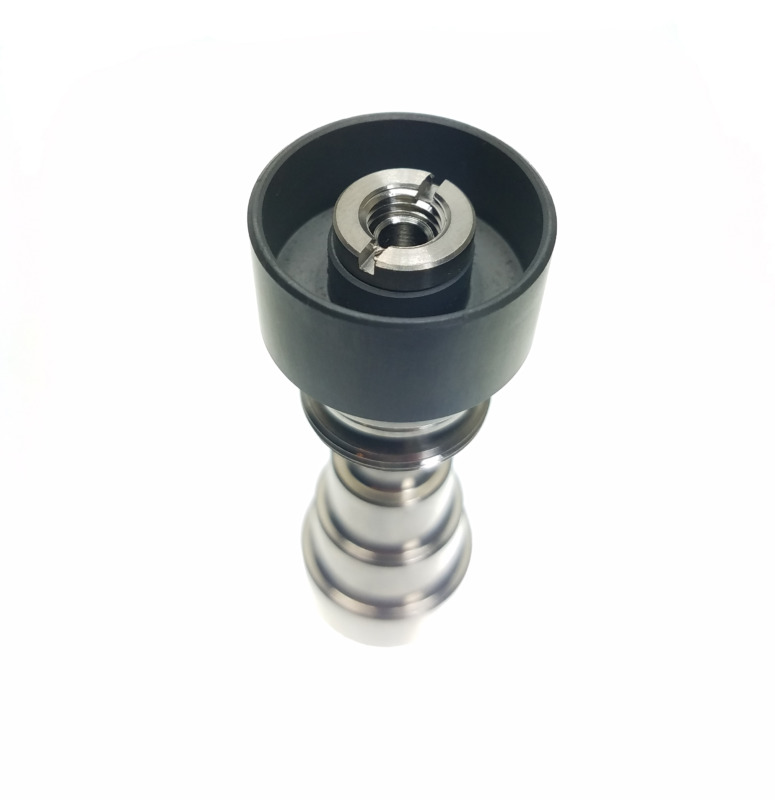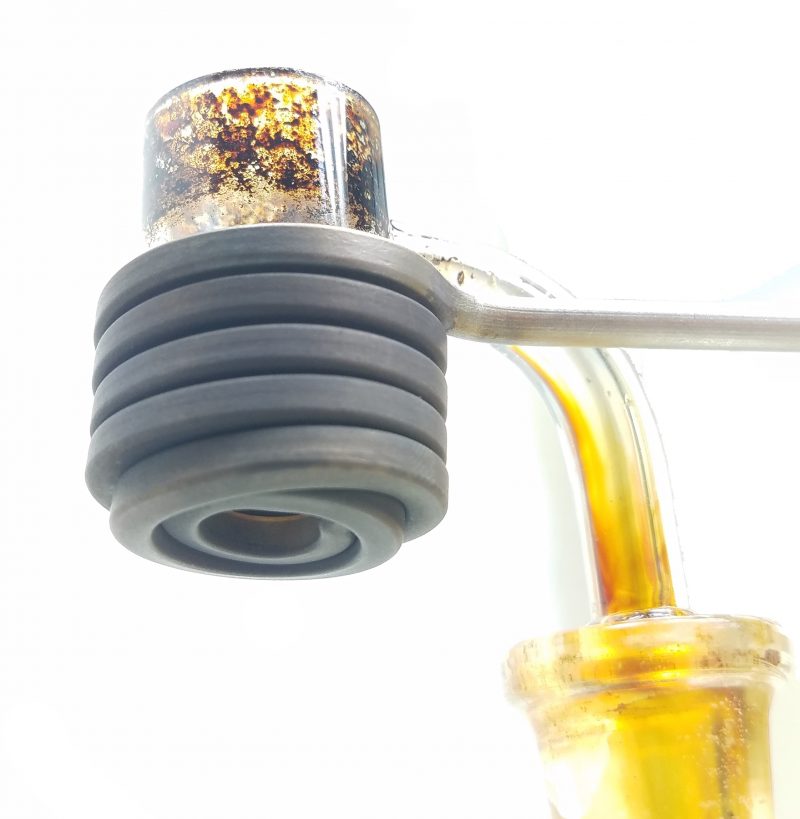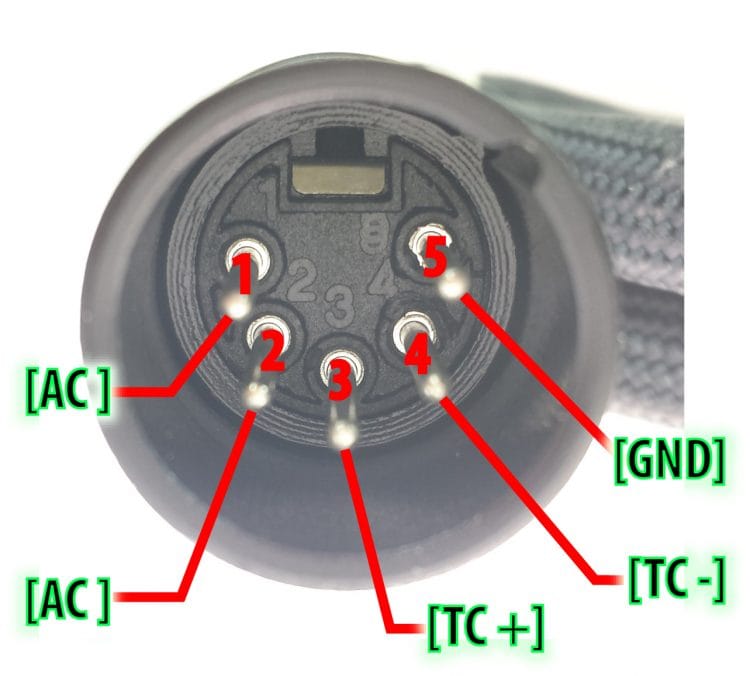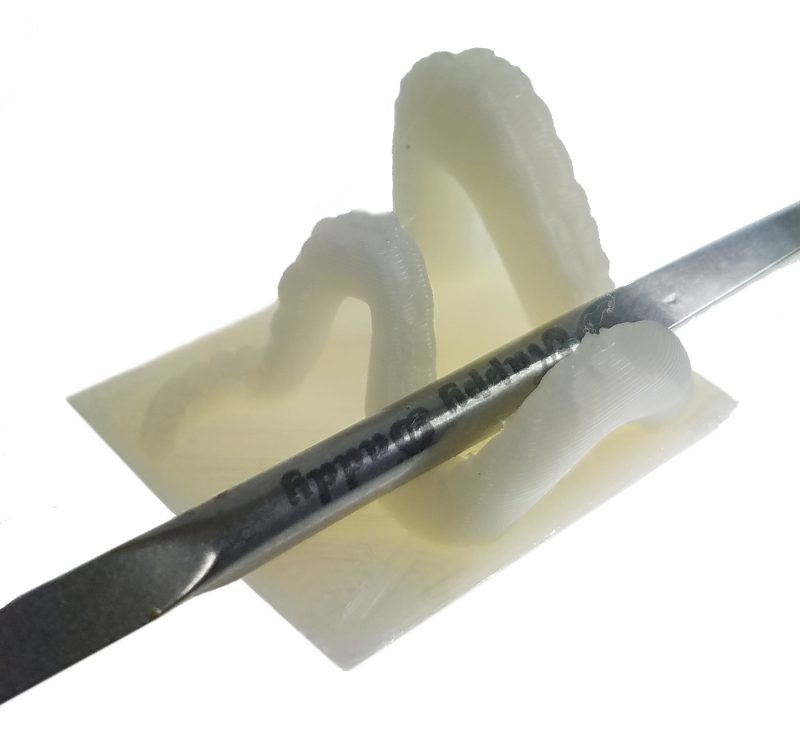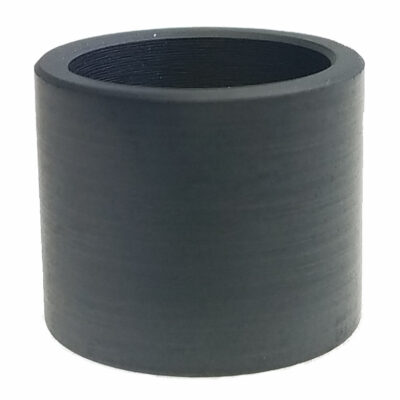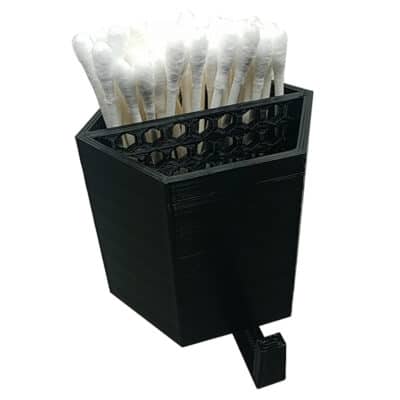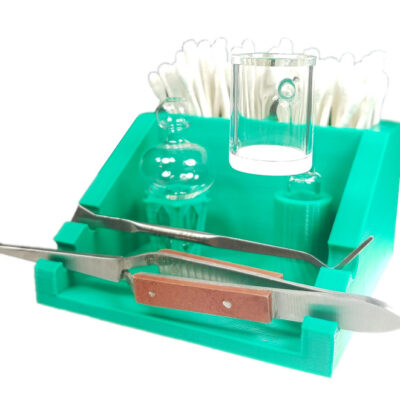Starting With Your Rig
Considering the wide selection of enail accessories available today, you’re likely to be a bit confused on where to start. Here’s a quick and solid guide to easily explain all of the most essential gear in any dabbing kit whether it’s for an e-nail or a torch setup.
The dab rig will dictate the joint size of the banger, so it’s probably best to start there. If you already have a dab rig, skip down and start with the nail and coil set. Then move on to the other accessories (there are a couple that you won’t want to skip and are relatively cheap).
If you don’t have a rig my advice is to pick up something less than a foot tall with a 14mm joint and splash protection. The reason most dab rigs are under 1′ is because more air and water mixture tends to make the dab stale and mute out the flavor of the terpenes. More reclaim can cool and collect on the larger surface which is less efficient both for the dab and the eventual cleaning.
Splash protection can include: recyclers (Klein and vortex style) or baffling (such as on the famous Fab Egg). Percolators (such as a honeycomb, showerhead, tree perc, etc.) can also bring their own form of splash protection, however beware that more percolation mixes more air in and can alter the flavor significantly. It also makes cleaning much more difficult, and sometimes close to impossible. After you decide on your optimal balance of percolation/filtration you’ll have one of the most important decisions out of the way when it comes to the rig. In my experience having less percolation is preferable, such as with a simple two hole or slotted diffuser.
Vortex recyclers prevent splashing by using a second internal loop inside the glass that makes the water fall back downward after it gets drawn up towards the mouthpiece. The vortex cone also acts as a splash guard that blocks the water from traveling directly up towards your mouth during the draw. This is far and away the most fool-proof way to prevent splashing. Recycler rigs are definitely the way to go if you can find one.
Dab Rigs Vs. Bongs
The main differences between a dab rig and a bong is the joint/stem attachment and size. Bongs normally have a stem, or even a lack of a stem altogether (which can be an issue with dab nails). The size of a bong is normally larger than a dab rig. This is why the aforementioned splash protection is so important with a smaller rig. That being said, pretty much any piece that doesn’t splash you and has a 14mm joint to attach to the nail should at least function just fine.
If it’s a heady bong you will want to separate the heat from the nail using a drop down or glass adapter of some sort. Most of the time you easily and cheaply find a glass adapter later to match various joint sizes together; but I would avoid 10mm unless you really love the rig because the air flow restriction can be a pain for cleaning and getting full draws. 14mm is pretty much the standard in 99% of all dabbing setups. 18mm nails pretty much always require an adapter to fit the rig.
Dab Nail Options
Next, it’s time to consider the desired dab nail for your setup. The major nail factors to consider are: material/flavor/clean-ability, durability, dish size, and budget.
Are you going to be dropping a lot of monstrous globs and snakes in? Or do you prefer medium sized to small “grain sized” dabs?
The quartz banger holds bigger dabs than a dish style and is by far the most common dab nail material used. A dish style nail benefits from being able to change out the top dish to quartz or SiC. while keeping the durable Titanium on bottom. If you prefer smaller dabs a dish may work better than a full quartz bucket since it can be less surface to clean later. Read on for information about common material types for your nail.
Dab Nail Material Types
There’s a variety of dab nail surfaces and materials out there to choose from. Most of it comes down to preference, but there are some functional differences to note. Preferences may be based on durability, heat transfer (shape and material), preferred dab size, flavor, and ease of cleaning. My personal favorite is a quartz banger with a SiC insert dropped in for flavor and ease of maintenance. The most common and popular materials are quartz, Titanium, and of course hybrids of Ti and quartz combined into one.
Titanium can be more difficult to clean without the use of high heat. You can soak it in ISO just like quartz, but it can be harder to clean that way and may even tarnish or degrade the metal if soaked for too long. Silicon carbide (SiC) is by far the easiest dabbing material to clean with an e nail, since you can just crank the e nail up to about 300F and produce sizzling water to gently lift up any crust you may have neglected to keep on top of.
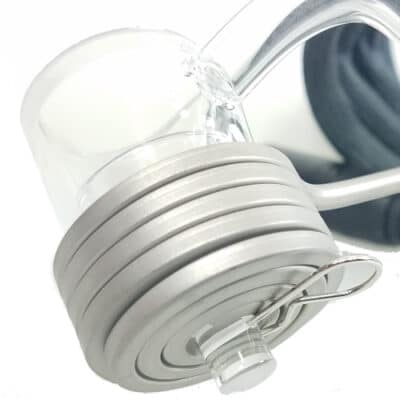
Coil/Nail Size Considerations
The popular 25mm heat coil will be 25mm on it’s inner diameter and the outer diameter of the nail will be approximately 25mm to match. To be clear, one of the two are ever so slightly larger or smaller than 25mm so that the two fit together without being too tight. If the fitment is very tight you may risk damage when the materials expand and contract upon heating and cooling.
The nail is often times about .5mm-1mm (about one grain of rice) under 25mm, but sometimes it’s a mix. The heat coil may be .5mm larger to accommodate the banger, since quartz tends to expand when cooling after production. If the gap is much wider the heat will not transfer as well; but if it’s much smaller you then risk scratching or even breaking the quartz nail during heating cycles; as mentioned above.
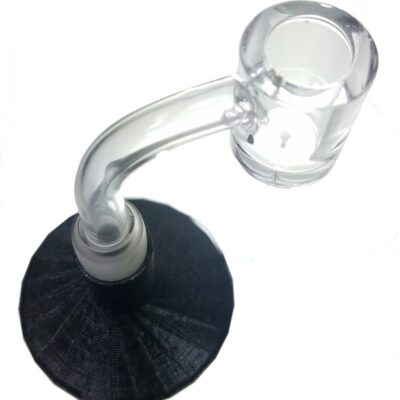
20mm Quartz Banger Nail:
A barrel shaped 20mm coil seemed to be the standard when dabbing first started getting more popular after legalization. 20mm is still preferred by some, however most like more surface area to get their “glob” on correctly and make sure it all gets vaporized evenly. More surface area equals more of the dab reaching the hot surface at once, and a quicker, more even heat distribution. If doing larger dabs, using a 20mm banger may result in too little surface area to effectively and quickly heat that dab before it puddles and basically just dries up on the dab surface.
25mm vs. 30mm Banger Comparisons
The larger bangers come in handy not only for more surface area, but for reduced cool down during and after the dab. It will take a much larger dab to phase a 30mm banger than a 25mm. Of course, there can be drawbacks with a more massive banger such as more weight. A larger banger also has a bigger heat coil (adding more weight) which can make a smaller rig slightly more likely to tip over if not positioned right.
If you have a smaller rig, or a rig that’s just a little top-heavy you’ll want to take steps to keep the center of gravity optimized. The simplest way is to rotate the banger so that it’s closer towards the rig rather than extending away from the rig. The most preferred way to rotate the coil/nail back is with a dropdown adapter. The adapter does double duty to also protect the rig joint from heat expansion (and possible cracking).
Of course a 30mm will also consume slightly more energy to get the larger banger heated fully; which may be a consideration for you as well. If switching the e nail off after each use, the difference will be much less significant.
Titanium Dab Nails
Even though quartz seems to be the most popular, there are some that still swear by Titanium products such as the late great Liger or NewVape Flowerpot. Ti lovers will tell you the heat transfer is faster, and tends to leave less left over at the end. Some even prefer the flavor of titanium over quartz. Personally, I prefer SiC if I am going with anything but quartz.
The quicker heat up and cool down of Titanium leads to a “hotter” dab at times. This might end up being a bit more harsh compared to quartz (depending on heat settings). That being said, there are some that always swear by their Ti for flavor and efficiency. Others just get plain tired of breaking their quartz every few weeks and need to stick with a more durable material.

Grade 2 Ti
What is Grade 2 Ti? What’s the difference? Grade two does not necessarily indicate any purity specifications. It is actually just a classification based on other material properties such as hardness and toughness/brittleness. These are more to do with what forces they can withstand; not counting chemical inertness or purity.
For purity ratings, look for the term “Medical Grade Ti”. This is the term that describes a Ti material with an extremely low impurity count. I personally prefer a hybrid Ti/quartz or SiC hybrid over straight Ti, since the heated dab surface has a purer flavor, yet still takes advantage of the durability Ti. That way I can take advantage of the sturdy and easily adaptable base, yet have the heat and flavor characteristics of quartz or silicon carbide.
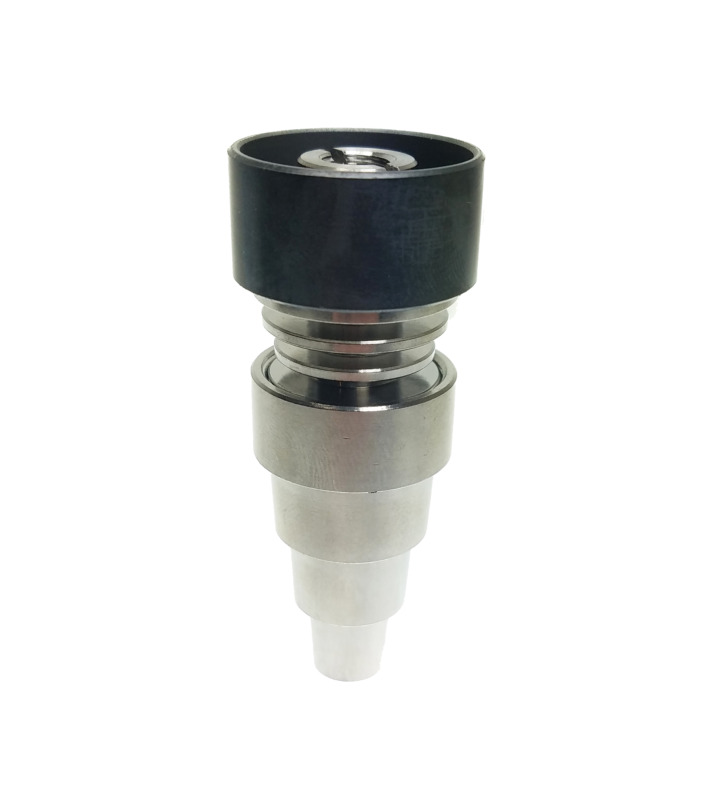
Hybrid Flexibility/Adaptability
If you just can’t decide between Ti and Quartz you can always have both! The “hybrid” style features a rugged base that’s adaptable for different quartz or SiC tops. One main advantage is that the tops are relatively cheap and easy to replace.
Also, if you plan on upgrading your dab rig in the future and are currently using something other than a 14mm female joint, this nail is reversible between male and female connections and fits a range of glass joints from 14mm to 18mm.
Replacement parts are inevitable in the long-run, although with regular cleaning this heavy duty dab nail should last much longer than a pure quartz banger.
Don’t get me wrong; the quartz Ti hybrids are a great solution for those seeking the durability and heat transfer of metal and you can always upgrade to the SiC dish in the future if you so choose.
NOTE: These hybrid nails typically use a flat coil; although some axial coils may also fit with some careful considerations.
Hybrid Ti/Quartz Nail:
The Ti/quartz hybrid is a handy nail which features the best of worlds. The Ti base has a screw-on threaded body to accept a removable quartz dish on top. This allows for easy and cheap swapping of the top ends. It also helps to provide easy access to the inside of the Ti base when it comes time to clean out residue deposits.
Dabbers who are more accident prone or who enjoy packing their kit for on-the-go dabs might prefer the durability and straight shape of this nail. It’s disassemble-able form allows for easy cleaning and facilitates safer transport in Peli cases or other similar weatherproof cases.
Ti/SiC Hybrid Nail:
It’s a close match between Ti and quartz, but for me it’s not even close compared to silicon carbide (SiC). SiC is a highly rugged metal-like material that is actually technically a ceramic. For those who need that durability but also aren’t a fan of Ti as a dab surface, the Ti/SiC hybrid is a great option. For those who are less accident-prone and don’t mind a slightly longer heat up time, a SiC insert sitting inside a quartz banger is highly recommended!
For those that want to get the most flavor (and clean-ability) for their money without breaking the bank, the SiC hybrid Ti is a great daily driver. I used mine for around a year until I switched to a SiC insert inside a quartz banger and was still coming out almost totally clean after a super quick water-treatment (see instructions here).
Silicon Carbide Insert In a Bucket
A SiC insert in a banger bucket has been my go-to for years and I don’t imagine that will change anytime soon.
SiC stands for silicon carbide. This is not the same as silicone (with an e at the end) that you see in dab mats and containers. SiC is a unique ceramic material that stands in a category of it’s own. It looks, feels, and performs much more like it’s metal, but in fact it’s technically a ceramic. You probably wouldn’t believe it’s ceramic unless you actually looked it up and did some research on it (or just take my word for it)!
SiC has amazing thermal properties that allow it to take on and radiate heat faster than both quartz and Titanium and has a durability in between the two. The surface qualities make cleaning way easier than anything that has ever come before it. You don’t even need ISO, just filtered water and low heat around 350F.
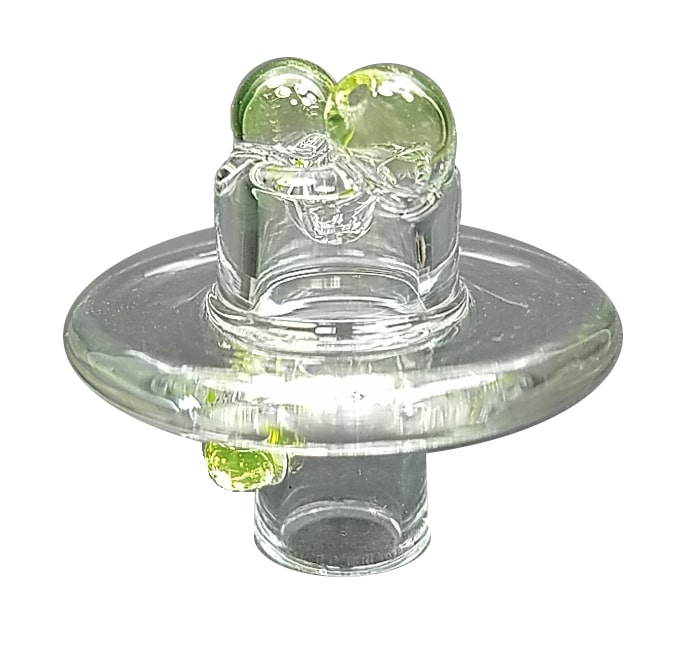
Spinner Capper Tools
An appropriate cap is important if you are trying to get your pearls whirling around that bucket. The optimal capper for spinning pearls will have either two (sometimes more) opposite/facing side holes or a perfectly aligned vortex pattern, such as the riptide capper by Gordo Scientific. These cappers create a circular airflow that resembles a tornado inside the nail, referred to as a vortex. Even without pearls the vortex pattern will help to swirl the product around and help to heat it more evenly and quickly.
The capper needs to have enough airflow, but also a tight seal on the banger rim. Other than that there are a few other considerations. If you are having trouble with your pearls read more here to find out how to make them spin more easily.
Cleaning Considerations:
Above all, my favorite part about SiC is that the Isopropyl-free (water) cleaning method works so much easier on SiC compared to quartz. I am still amazed how it still seems like new on the dab surface (although I have let some black deposits build up pretty bad on the outside of the nail, admittedly. After an easy cleaning procedure with a few drops of water and low heat the silicon carbide comes out almost brand new again; even after years of heavy usage! It’s the easiest nail to restore near-perfect flavor that I have experienced so far, hands down.
Ruby is nice but honestly not too much nicer than SiC and the cleaning procedure just requires too much care for the average user. The only surface material type I have not tested is Sapphire. It’s just too expensive and delicate for my taste knowing that the flavor is not significantly better than SiC. Silicon carbide is the best balance between quality and price by a long shot, and the best kept secret in dabbing, by far IMO.
Now let’s look at heating coils:
Before we go any further, it’s important that you know the all too common issue of coils not being compatible with different enail controllers. If you are buying a full set there’s no need to don’t worry, if they will match. However if you are buying part of a set here and the other parts there it’s very important to make sure the wiring order matches between the two plugs. This is the #1 most common mistake when purchasing a new enail part that I’ve seen.
If you are buying from separate suppliers or ever replace one part or another, it’s surprisingly easy to get mismatched parts. The wires connected to the 5 pins on your XLR plug for the heating coil need to be the same as on your e nail controller. Even though they look like the heat coil and e nail should physically match, often times the wires are switched around. This can make bad things happen beyond the inconvenience of having to send in a return! To find your wiring order, check out this XLR coil plug matching guide.
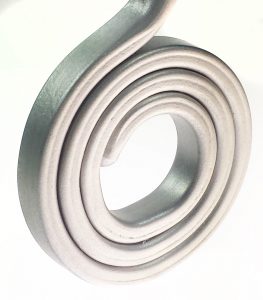
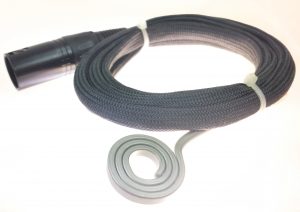
Flat Heating Coils:
Pictured (left) is a flat coil, which is normally seated directly underneath a dab surface and wedged in between that and the bottom of the nail body like a hamburger. The coil is sandwiched in-between the Ti nail and the SiC dish on top of the nail. Normally a fastening nut is screwed into a center post which goes through the middle of the flat coil shown here.
Flat coils seem to be preferred over barrel style heat coils (without bottom heating) by many enail owners. This is because a flat coil heats the bottom surface much more directly than a barrel style e-nail coil. Since heat rises, this is the most direct and efficient method of delivery for heat through the dab surface. To get the best of both worlds, check out the axial style coil, which has both side and bottom heating.
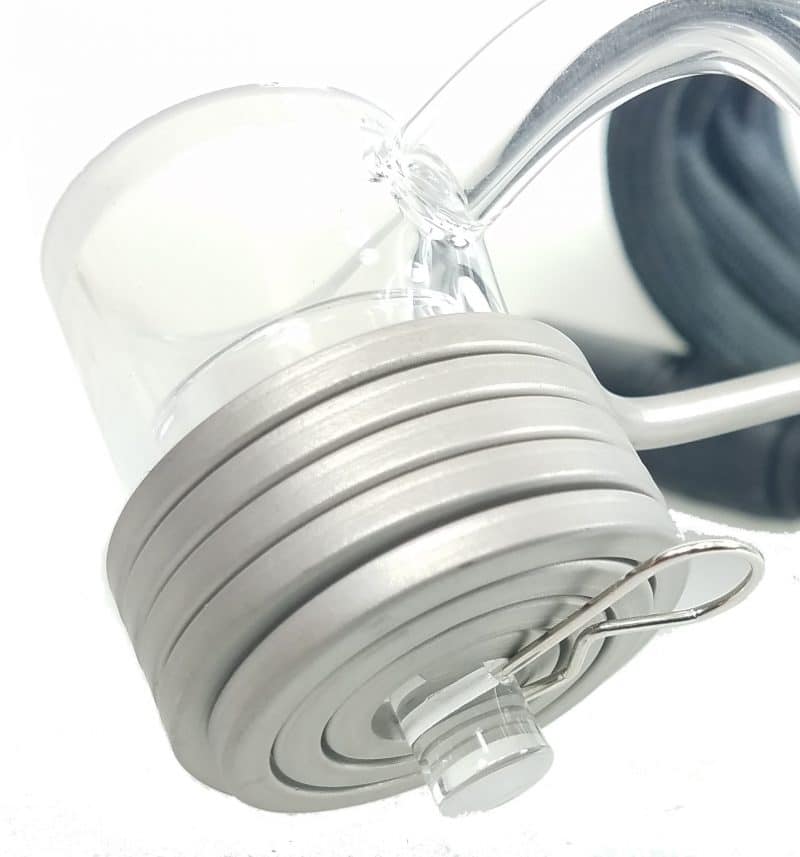
Axial Style Coils
Most dabbers today seem to default to bangers. For bangers, the barrel style with bottom wraps is the clear choice. This barrel style coil is sometimes called an “axial coil” (even though that technically just means round and doesn’t have anything to do with the bottom wraps).
This style of barrel coil has bottom wraps which directly heat the bottom of the dab surface, along with the side walls. A standard barrel coil will work too, but you will be turning the temps up just a little bit more to get everything vaporized (unless you have the “waste it to taste it” philosophy).
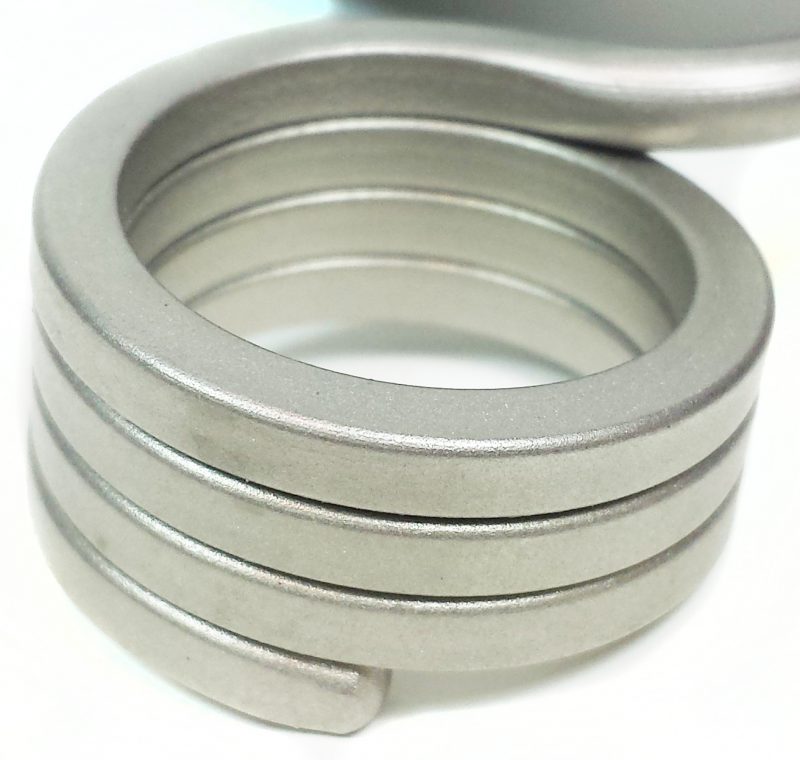
Barrel vs. Axial Style Coils
Dabber Tools
Most importantly, you need a dabber tool. This is one of the enail accessories that is very difficult to go without unless you only do shatter “layups”. A good dabber and capper combination tool can be a handy piece of gear for the convenience of not having to switch tools mid-dab. This isn’t really a must-have. You can easily get used to using two separate tools. It just means one more enail accessory on the dab table.
The functional reason you may prefer two separate tools is to have a more specialized capper. The flat lollipop capper, for example, does not seal quite as well as a bubble capper normally can. Some other combinations may lack the function that say a riptide capper might be able to offer with spinning terp pearls.
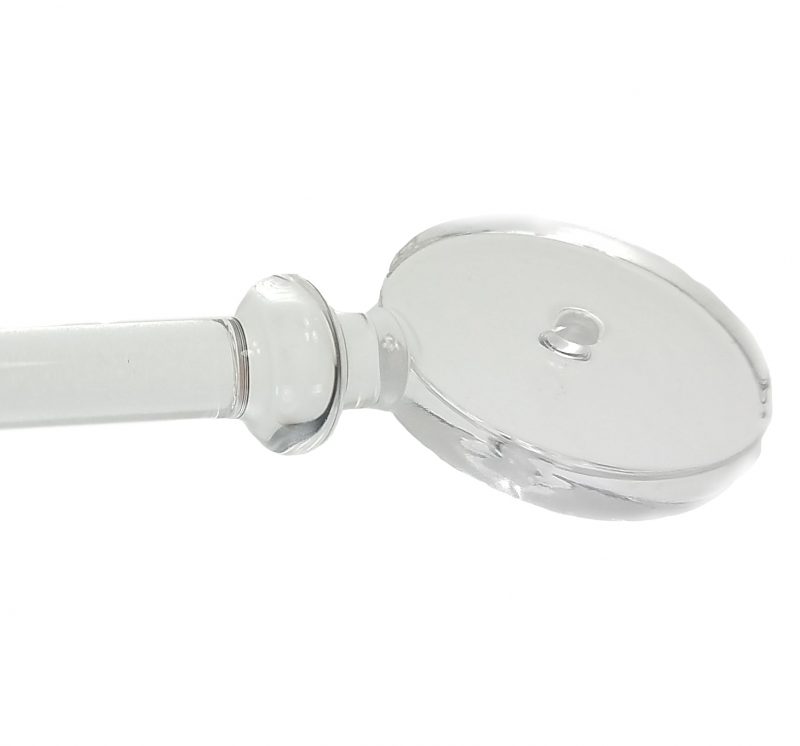
Dab Tool Selection (Tip):
If your dabber tool is made of glass, it’s best to have a thin point on the end. Otherwise, the dab will want to stick onto the colder surface and just melt/stick to the side of the tool. This can get a little wasteful and frustrating. Glass tools stay relatively cooler than metal, so the dab will want to stay on the cooler surface and even re-condense there after heating. For metal this is less important, since it transfers the heat faster and more completely.
A metal tool that I really like which works well for a variety of concentrate consistencies would be the double sided stainless steel scoop tool. This has both a large scoop on one end and the smaller on the other. The larger end works well for dryer material that likes to fall off of a smaller scoop, while the smaller end works well for anything that tends to stick to the dab tool and not want to leave.
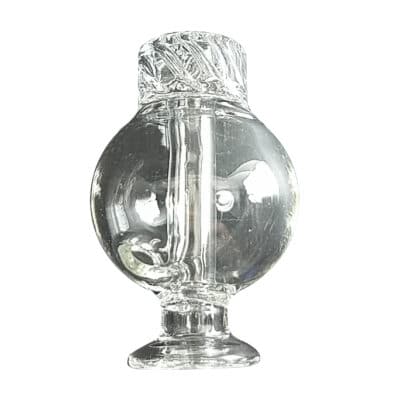
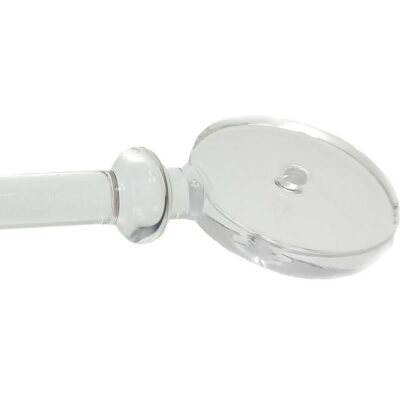
Capper Tools:
A capper tool comes in as the most highly recommended dab accessory beyond the core components. It’s commonly overlooked by beginner dabbers, yet the easiest and cheapest way by far to upgrade your dab experience. I can’t see myself ever going without one. It would be a huge waste of product. Anyone who has experienced the difference with and without will surely agree.
Cappers make the dab vaporize faster and keep it from escaping from the bucket. Increasing vacuum suction makes liquids boil at a lower temperature, so less heat needs to be applied for the same amount of vapor to be produced!
A good capper tool is the single most important dab accessory to have for successful low temperature dabs for this reason. Not only does the cap allow you to preserve terpenes and keep them from escaping; but also reduces consumption of concentrates and energy. It also is better for your health. A capper opens up more ability to dab only the best parts while leaving lipids, benzene, and less desirable plant matter behind.
If you absolutely need to skimp on this you can turn the heat up to get by if needed, or use a flat glass surface such as a glass dab container, but even a cheap capper will have a much better seal and is highly recommended.

Inserts: Quartz, SiC, Ruby
Inserts perform at least two important functions. The first is helping to keep a banger clean for longer, since it is removable. If you are into high temperature dabs and using an enail you’ll find that the steady heat contributes too dry, crusty build-up, which ruins the flavor if not regularly cleared. With low temp dabs this is less of an issue as long as it’s q-tipped after the dab. With new materials like SiC (silicon carbide), you can get away with a lazy cleaning regimen because the dab won’t stick to the surface nearly as easily. When it does, it’s easily removed with just sizzling water at about 350F.
There are many great options for inserts available. Ruby is another that seems to have been hyped up quite a bit but which down a bit in the past year. SiC seems to be the preferred premium surface since it costs about half yet performs even better in the eyes of most. Quartz is still a good go-to option as well, although less durable than SiC. It also has inferior thermal transfer properties and is much harder to keep clean.
The thing about inserts are you won’t need to replace the whole nail to start with a fresh surface. Just pop one of these in and you’re good to go. They can extend cleaning times by quite a bit. The insert can be removed using a tweezers right after the dab so you don’t have to wait forever make sure it’s cool enough to handle.
Insert Height (Tip):
Keep in mind the height of your insert makes a difference if you have a spin capper, or one with a rotating air spigot of some sort for directional air flow (like a bubble or directional style capper tool). Some inserts might be too tall for the spigot on a bubble cap. Also keep in mind the placement of the neck on the banger (where the intake hole is). Make sure that the top of the insert does not rise past the intake hole inside the quartz banger, or the airflow will be negatively affected and you will also have extra unwanted reclaim inside your banger.
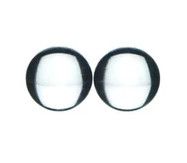
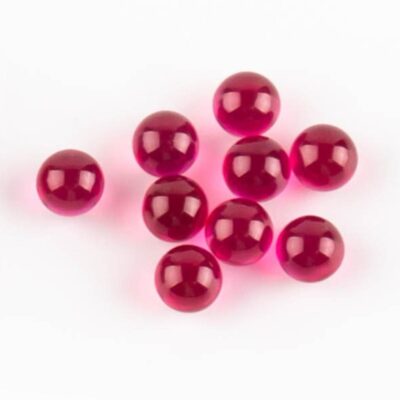
Pearls
Many people overlook the advantages of this simple but effective enail accessory. Pearls/beads are some of the most slept-on enail accessories. They increase and optimize the dab surface area, as well as help to bring out more flavor and decrease maintenance. Pearls also work well with inserts. You might be surprised how much better your setup performs with a seemingly small addition.
I have a feeling that the low cost may also be why there’s less hype about them. There’s not a whole lot of money to be made on such a small upgrade. Nevertheless, they do help out quite a bit to expose more dab to heated air. They also help to curb climbing up the side walls quite a bit.
Read more here about how to spin dab pearls and how to use them. Find out why people use terp pearls and why they are the best and easiest addition to upgrade your setup.
Axial Banger Coil Holders: Ties, Bands, Clips, and Pins
Of course it’s important to have a way to hold the coil up on the banger to keep it from falling off during use. Most bangers that are made for an enail are designed with this in mind. However, if you’re switching from a torch to an enail setup it’s important make sure you have this part covered if you’re planning on using your old torch accessories with enail accessories. Most bangers made for a torch are not made to attach to an enail coil.
If you don’t have a solution yet there are some simple solutions you can use in the meantime, or if you lose a part and get yourself in a pinch. While you’re waiting for your specialized solution to arrive you can just MacGyver up this solution from common items you can easily find for free until you have something legit. Any thin and decently strong wire tie made of copper, steel, or even aluminum can be used. The quickest and easiest way to hold your coil to the banger in a pinch is to use a twist tie. The paper, or plastic cover is fairly easy to strip off, giving you a free banger holder next time you stop by your local grocers and pick up that mango to add some myrcene for terpene boost and entourage effect. If you ever lose your go-to you can always fall back on this backup method.
I’d stay away from the built-in arms that you may see on some quartz bangers. They need to be positioned really precisely in order to make even decent contact between the nail and coil. It unfortunately can’t be placed perfectly because of the way the angles work out. Basically if it were in the perfect tight position the coil wouldn’t to fit over the arm and under the banger without breaking the arm off. It’s a bit difficult to explain but take my word for it. Or try it yourself, but if you aren’t disappointed with the fit I bet you will be when the arm eventually breaks off! If a removable arm were possible this might be a good design.
The best solutions are removable and/or adjustable banger bands/holders, and clips. Read more about these here. They allow you to strap your axial coil right up to the banger stem. You can even use more than one to get that perfect, leveled fit.
Q-Tip Holding Accessories
If you already topped your budget out on all of the enail accessories above; but still need a q-tip caddy, don’t worry about that. Although q-tip holders are great for quick access, you can easily make your own DIY q-tip holder out of recycled materials, such as a pop-top dispensary container that you normally get your flower in at the dispensary. Just remove the top, rinse, dry, and pop in your tips!
Capper, Dabber, & Nail Stands
Stands and holders are a great addition to help keep your dab tools and accessories all together in one spot. It’s easy to forget that you put your capper or your swabs across the table only to realize in the middle of the dab that they’re out of reach when they matter the most. You can save some time cleaning reclaim off of your table surface by keeping your tools and accessories in a holding stand. You can also save time and effort cleaning by leaving one nail soaking while the other is being used.
Aside from the pragmatics, having some organizing gear just makes your dab station that much nicer to look at, of course!
Dab Mats, Pads, and Coasters
The main purpose of a dab mat is to have a nice soft base to set down your rig and enail accessories. Some rigs have a small base and tip over easily. There are ways to help prevent this, but you may want to get a mat that is big enough to absorb some impact in the event that your glass has a tendency to tip. A silicon pad can also take some heat from a hot nail for a very short period of time, but it depends how hot the nail is. It will probably melt and stink a little but at least your nail and table should still be in tact if you catch it in time.
Besides holding your rig, accessories, and concentrates, the second purpose of a dab mat is to protect your table. Oil drips, smudges, and stains are all to familiar to any daily dabber.
And of course who doesn’t love adding some cool artwork in the mix? There are a ton of designs out there ranging from simple geometrical patterns to extra heady signature works by glass artists and dab mat artists. Check out the rad and original art work of KillerAcid at Moodmats for a prime example of what I’m talking about!

